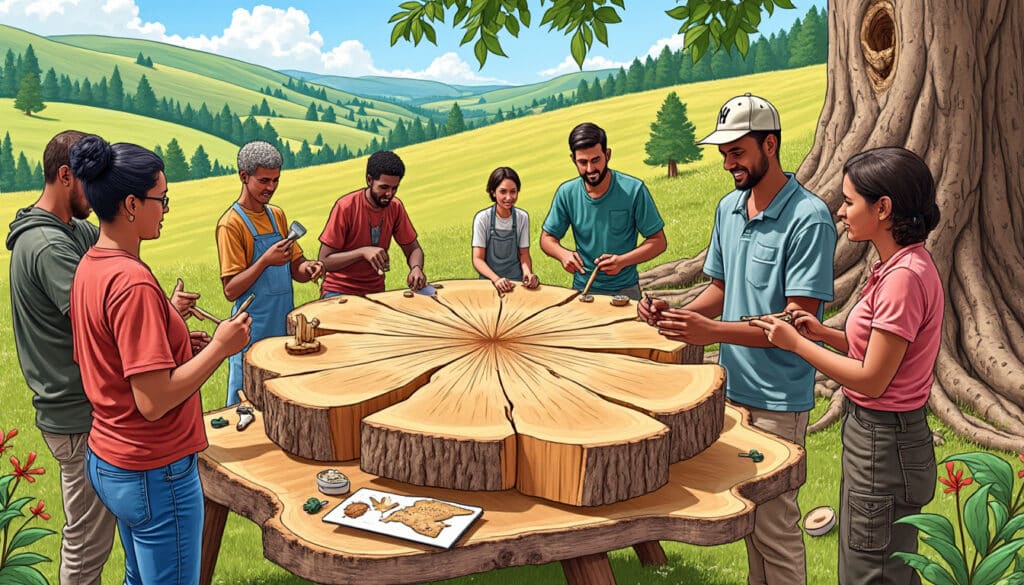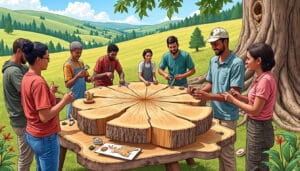Ancient hedges have shaped the British landscape for centuries.These living remnants tell the story of agricultural practices rich in biodiversity.Today, they are at the heart of an ecological revival.
On Dartmoor, near Yar Tor, a 30-meter ridge crosses the moorland, reminiscent of the fleeting trails left by planes. These hedges, called reaves, are the skeletons of past agricultural practices, harboring a multitude of species. Despite their wild appearance, they represent one of the oldest agricultural lands in the UK. Current initiatives aim to restore these hedges to support wildlife and preserve this natural heritage. In England, hedges form the largest nature reserve in the country, providing a refuge for over 500 plant species and numerous animal species. Collaboration between communities, farmers, and associations allows for the planting of hedges rich in biological diversity. Each hedge planted today contributes to a greener and more sustainable future for generations to come.

the history of ancient hedges in England
The ancient hedges of England represent an invaluable landscape and ecological heritage. These hedges, locally called reaves, stretch for hundreds of kilometers across regions such as Dartmoor. Originally, these bands of vegetation served as boundaries for agricultural lands, but they also played a crucial role in maintaining biodiversity. Made from various shrubs and trees, ancient hedges are the result of several centuries of agricultural practice, reflecting traditional cultivation methods and the harmonious interaction between humans and nature. Each hedge tells a story, marked by different eras, from the Bronze Ages to the Middle Ages, witnessing the changes in land use and farming management techniques.
the ecological importance of hedges for wildlife
Ancient hedges constitute vital wildlife reserves for a multitude of animal and plant species. They provide a diverse habitat that supports over 500 species of plants, 60 species of nesting birds, and nearly all species of native small mammals. These bands of vegetation serve as ecological corridors, facilitating the movement of animals between fragmented habitats. Birds find secure nesting sites, while mammals use the hedges as places of refuge and foraging. Additionally, hedges harbor a variety of lichens, mosses, and pollinating insects, thus contributing to the overall health of agricultural ecosystems. The structural diversity of ancient hedges, with their multiple layers of vegetation, creates microhabitats conducive to wildlife, enhancing the resilience of ecosystems to environmental pressures.
current challenges in preserving ancient hedges
Despite their ecological importance, ancient hedges face numerous challenges that threaten their survival. Agricultural intensification and urban development have led to the destruction of many hedges, thus reducing the total area available for wildlife. Moreover, modern land management practices, often focused on productivity, do not always consider the need to maintain diverse habitats. The lack of funding and resources for restoration programs further complicates the situation. Furthermore, the loss of traditional skills, such as the technique of laying and weaving hedges, limits preservation efforts. Without proactive intervention and supportive policies, ancient hedges risk disappearing, leading to a significant decline in biodiversity and the loss of valuable habitats for wildlife.
restoration and planting initiatives
In response to these challenges, many initiatives have been launched to restore and preserve ancient hedges. Partnerships between farmers, community organizations, and environmental associations, such as Hedgelink, work together to plant and restore hedges rich in biodiversity. These programs aim not only to recreate historical hedges but also to integrate native species that support local wildlife. Volunteer engagement is also crucial, with planting days where hundreds of meters of hedges are created in a single day. These collective efforts help stabilize and potentially increase the total length of hedges in the country. Furthermore, awareness campaigns are conducted to encourage landowners to preserve and maintain their hedges, highlighting the ecological and aesthetic benefits they bring.
techniques for restoring ancient hedges
The restoration of ancient hedges relies on traditional techniques that require specific expertise. Laying, or weaving hedges, is a crucial method involving the cutting and bending of shrubs to intertwine them, thereby strengthening the structure of the hedge and promoting the growth of new shoots. This technique helps keep the hedge healthy and prevents it from turning into a line of trees. However, the know-how required to perform laying is gradually being lost, making this practice less common among modern farmers. To address this gap, training and workshops are organized, imparting the skills needed to new generations of hedge managers. Additionally, the use of modern technologies, such as laser scanning, helps to map and plan restoration efforts more effectively, ensuring better preservation of ancient hedges.
the long-term impact of hedges on biodiversity
Ancient hedges play an essential role in the long-term preservation of biodiversity. By providing varied habitats, they support a multitude of species that depend on these structures for their survival. Hedges also act as natural barriers against erosion and contribute to managing runoff water, thus improving the quality of soils and waterways. At a carbon level, hedges contribute to carbon sequestration, helping to mitigate the effects of climate change. Moreover, ancient hedges serve as living witnesses to the agricultural and cultural history of the region, enriching local heritage. Ongoing restoration and the planting of new hedges ensure that these benefits persist, strengthening the resilience of ecosystems in the face of environmental challenges and ensuring a sustainable future for England’s wildlife and flora.
the economic benefits of restored hedges
In addition to their ecological advantages, restored hedges also provide significant economic benefits. They can serve as windbreaks, protecting crops from strong winds and thus reducing agricultural losses. Hedges can also promote crop pollination by attracting pollinators such as bees, thereby improving agricultural yields. Furthermore, ancient hedges have become tourist attractions, drawing visitors interested in nature and rural heritage, which stimulates the local economy. Hedge management also creates jobs in agriculture, conservation, and environmental education. By investing in hedge restoration, local communities can benefit from a dual green and traditional economy, supporting both environmental preservation and sustainable economic development.
the role of public policy in preserving hedges
Public policies play a crucial role in the preservation and restoration of ancient hedges. Regulations, such as the hedgerows regulations introduced in 1997, offer legal protection for hedges, preventing their destruction without appropriate authorization. Furthermore, governments have implemented financial incentives to encourage farmers to create and maintain hedges, recognizing their ecological and economic value. Long-term commitments, such as the goal to create or restore 45,000 miles of hedges by 2050, demonstrate a strong political will to preserve this natural heritage. However, to ensure these policies are effective, they must be accompanied by adequate funding and technical support for farmers. Collaboration among various stakeholders, including local communities, non-governmental organizations, and farmers, is essential to ensure the successful implementation of preservation initiatives.
the future prospects for ancient hedges in England
In the future, ancient hedges in England have immense potential to continue supporting biodiversity and strengthening agricultural ecosystems. With ongoing restoration and planting efforts, it is conceivable to maintain and even increase the total length of hedges, thus ensuring stable habitats for wildlife. Technological advancements, such as laser mapping tools, will allow for more precise and effective management of hedges. Additionally, educating and raising awareness among younger generations about the importance of ancient hedges will ensure the transmission of knowledge and skills necessary for their maintenance. By integrating hedges into agricultural and environmental policies, England can serve as a model for other countries wishing to preserve their natural landscapes and biodiversity. Finally, the growing recognition of the value of ancient hedges reinforces the collective motivation to protect them, ensuring their survival for future generations.
the role of local communities in restoring hedges
Local communities are at the heart of efforts to restore ancient hedges. Their active involvement is essential for the success of planting and maintenance initiatives. Volunteer groups, rural schools, and environmental associations often collaborate to organize planting days, raise public awareness, and train new generations in traditional hedge management techniques. For example, community projects in Dartmoor have mobilized dozens of volunteers to restore sections of hedges, thereby strengthening the bond between residents and their local environment. Furthermore, sharing knowledge and resources among community members fosters a collective and sustainable approach to hedge preservation. Local engagement also creates a sense of ownership and responsibility, encouraging residents to protect and appreciate hedges as an integral part of their natural and cultural heritage.
the educational benefits of restored hedges
Restored ancient hedges also offer valuable educational opportunities. They serve as living laboratories for studying biodiversity, ecology, and agricultural history. Schools and universities can use these hedges for research projects, practical courses, and environmental awareness programs. Students thus learn about the importance of habitat conservation and ecological management techniques. Additionally, hedges can be integrated into nature discovery programs, where participants can directly observe the complex interactions between different species and their environment. These educational experiences enhance understanding and appreciation of the value of ancient hedges, cultivating a new generation of environmental guardians.
technological innovations in the service of ancient hedges
Technological advancements play an increasingly important role in the preservation and restoration of ancient hedges. Laser scanning technologies allow for precise mapping of existing hedges, facilitating the planning of restoration efforts and tracking their progress. Additionally, the use of drones to monitor the health of hedges and detect areas needing intervention enables more proactive and effective management. Digital tools for managing environmental data also provide valuable insights into the impact of hedges on biodiversity and local ecosystems. By integrating these technologies, restoration initiatives can become more precise, resource-efficient, and adapted to contemporary conservation challenges. These innovations pave the way for a better understanding and management of hedges, ensuring their sustainability and continued contribution to English biodiversity.
the partnership between farmers and ecologists
The success of restoring ancient hedges largely depends on the collaboration between farmers and ecologists. Farmers, as stewards of the land, bring valuable knowledge of agricultural practices and local specifics, while ecologists provide expertise in biodiversity and habitat management. This symbiotic partnership enables the development of restoration strategies that reconcile agricultural productivity and ecological conservation. For instance, by integrating hedges into farming operations, farmers can benefit from ecosystem services such as increased pollination and natural pest regulation. Ecologists can use these hedges to create ecological corridors and promote species migration. This mutually beneficial collaboration demonstrates that it is possible to reconcile agricultural development and biodiversity preservation, paving the way for more sustainable and resilient land management models.
#>
Articles similaires
Thank you!
We will contact you soon.














